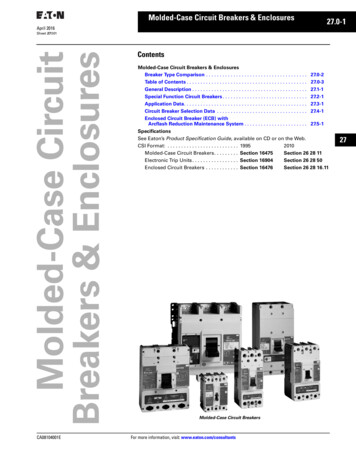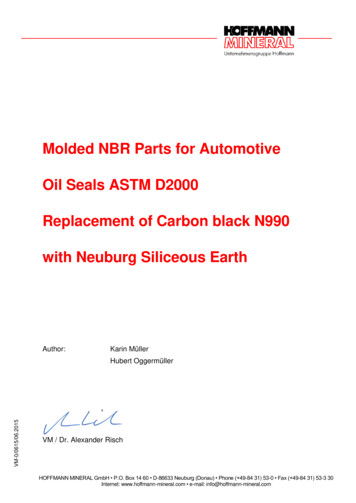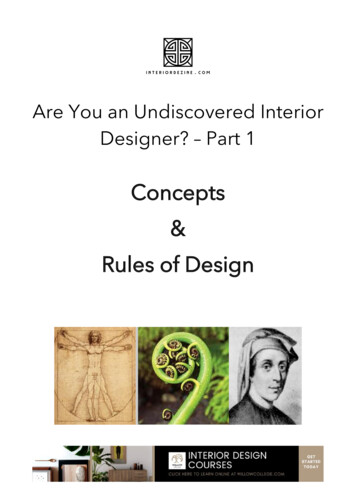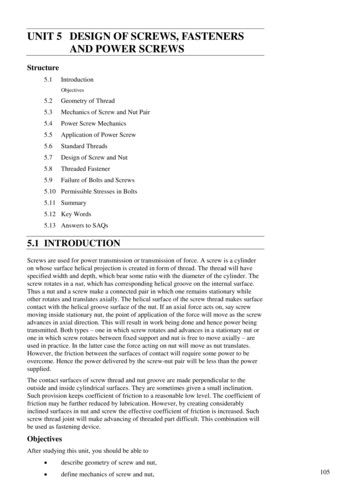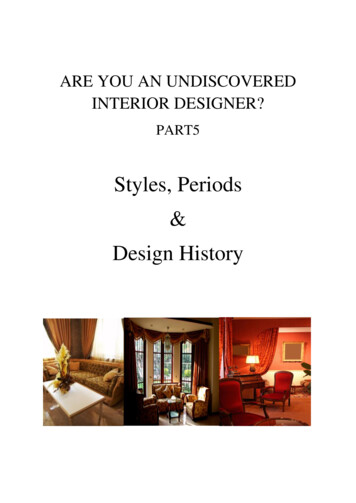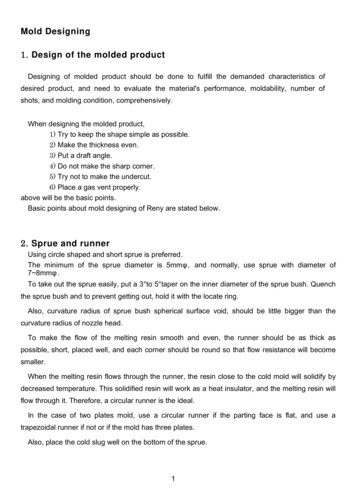
Transcription
Mold Designing1. Design of the molded productDesigning of molded product should be done to fulfill the demanded characteristics ofdesired product, and need to evaluate the material's performance, moldability, number ofshots, and molding condition, comprehensively.When designing the molded product,1) Try to keep the shape simple as possible.2) Make the thickness even.3) Put a draft angle.4) Do not make the sharp corner.5) Try not to make the undercut.6) Place a gas vent properly.above will be the basic points.Basic points about mold designing of Reny are stated below.2. Sprue and runnerUsing circle shaped and short sprue is preferred.The minimum of the sprue diameter is 5mmφ , and normally, use sprue with diameter of7 8mmφ .To take out the sprue easily, put a 3 to 5 taper on the inner diameter of the sprue bush. Quenchthe sprue bush and to prevent getting out, hold it with the locate ring.Also, curvature radius of sprue bush spherical surface void, should be little bigger than thecurvature radius of nozzle head.To make the flow of the melting resin smooth and even, the runner should be as thick aspossible, short, placed well, and each corner should be round so that flow resistance will becomesmaller.When the melting resin flows through the runner, the resin close to the cold mold will solidify bydecreased temperature. This solidified resin will work as a heat insulator, and the melting resin willflow through it. Therefore, a circular runner is the ideal.In the case of two plates mold, use a circular runner if the parting face is flat, and use atrapezoidal runner if not or if the mold has three plates.Also, place the cold slug well on the bottom of the sprue.1
3. GateDirect gate, side gate, pinpoint gate are well used as a gate. Also, disk gate, fan gate, tab gate,and submarine gate can be used depending on the shape of the molded product.(1) Direct gateThis type is often used when molding Reny.Its good point is that the shape is the same as the sprue, but the corner of the joint partbetween the molded product and the direct gate must be round and make the flow smooth.The bad point (about the direct gate) is that residual stress tend to occur because the injectionpressure will be put on the molded product directly. The other bad point is that if the sprue baseis too thick, a sink mark and air bubbles will be generated, especially if the thickness is notenough. A diameter of sprue base should be 1 to 2 times bigger than the thickness, if thethickness is not enough.Furthermore, the gate must be chopped off afterwards, and if coming up outside, finishing willbe necessary.(2) Side gateMolding is relatively easy, and gate mark is small, so this type is mainly used. Gate sizedepends on many factors such as flow property of the material, molded product thickness, resinamount that will be injected to the cavity, and resin temperature.Gate depth should be more than the half of the molded product thickness, optimally 2/3.Also, gate location and thickness need to be chosen so that the resin flows from the thick part tothe thin part.Glass fiber tend to be oriented in a flow of the melting resin, so the gate location is important toprevent the deformation and warpage as possible after molding.If side gate is used on cup or box shaped molded product, resin in the one side of the cavitywill flow fast, and the core will get out of alignment by that pressure difference. Therefore, thethickness of the other side will be thin, and the weld line will get weak, so the molded productwill also get weaker. If that happens, the center gate should be used instead.Additionally, twist setting of the mold is necessary to prevent the core from falling down. Also,when the molded product is thin and long, if the gate is put on the longitudinal direction, jettingwill occur, so put the gate on transverse direction. (Figure 1)JettingF i g u r e 1 Side gate location2
(3) Pinpoint gateThis type is also mainly used in Reny, even though the mold construction is bit complicatedbecause of the three plate mold with single or multi-cavity mold, since the gate mark is smalland after processing is unnecessary.0.8 2.0φ is u s e d as a g at e d i a m e t e r , b u t 1 1.5 is standard.In the case of a thin molded product, if the gate is made too thick, a part of the moldedproduct will be taken, so be careful.However, if the gate is too thin, sink marks will occur because of insufficient pressure keepingby liquidity degradation, and faster gate solidification, so designing thicker would be better.To prevent the warpage of the molded product, pinpoint gate is most suitable, but the weldmight occur, and from that influence, warpage and deformation might occur, so the number ofthe gate should be decided after the experimental molding.4. Draft angle(1) Box or lidTo eject the molded product from the mold easily, a draft angle is necessary.This draft angle differs by the molded product shape, material types, mold construction, andfinishing state of mold surface, but need at least 1/30 1/60(2 1 ).Reny is a material will relatively small molding shrinkage, so demolding defect might happendepending on the mold. Therefore, if taking a draft angle in a large degree is harmless, takeas big as possible.(2) GridFigure 2 Draft angle of grid shaped molded product1.5( A-B)/H 1/9 1/11If the grid pitch (P) becomes smaller than 4mm, make the draft angle 1/10.Take the draft angle big as the grid part (C) get bigger.3
(3) Longitudinal ribF i g u r e 3 Rib inside the wallF i g u r e 4 Rib outside the wallThe draft angle of longitudinal rib, mainly used as a reinforcement, depends on the thickness ofthe side wall and the base, but the draft angle that is used commonly is indicated.1.5( A-B)/H 1/350 1/200Figur e 3 indicates rib inside the wall, and Figure 4 indicates rib outside the wall.A T (0.5 0.7) If sink marks are permissible, the number need to be (0.7 0.9)B 1. 0 1.8mm Because there is a restriction on working.(4) Base ribThe base rib is used like the longitudinal rib, and the draft angle is also chosen by the sameidea as the longitudinal rib.The draft angle used commonly is1.5( A-B)/H 1/150 1/100A T (0.5 0.7)If sink marks are permissible, the number need to be (0.7 0.9).B 1. 0 1.8mm Because there is a restriction on working.F i g u r e 5 Rib with base4
5. Molded product thicknessTo make a good molded product, the thickness need to be even. However, sometimeschanging the thickness is necessary because of the mold construction or molding.Consider about the following points when deciding the molded product thickness1) Constructional strength2) Strength when demolding3) Equal distribution of power against impact4) Crack prevention on embedded clasp part(Crack that happens when shrinking by the difference of the molding material andthe metal heat expansion)5) Reinforcement of weld that occurs on hole, window, and embedded clasp part6) Sink mark prevention at the thickness part7) Prevent the filling from lacking, by making the flow better at the knife edge shapedpart and thin part.As a disadvantage of the thick molded product, it tends to generate sink marks, takes morecooling time when molding, and the amount of the material will be bigger.On the other hand, if it is too thin, the liquidity will degrade, require a lot of injection pressure,and if the weld line is on the thin part because of the gate location, crack tends to occur. (seetechnical data "Injection Molding" to find out about the liquidity of Reny)Reny is a material with relatively less sink marks and warpage, but when the molded productis thin, warpage might happen, so appropriate thickness is necessary.Also, in the case of molded product of Reny which thickness is 1mm to 2mm, the crystallizationwill be not enough if the mold temperature is below 120 , and end up with low heat distortiontemperature because of the rapid cooling. Therefore, molding should be done in about moldtemperature of 130 if the molded product is thin, and to prevent a warpage, countermeasurelike using reinforcement rib is necessary.Furthermore, about the molded product which is thicker than 3mm, it will crystallize and moldedproduct without practical issue can be attained even if the mold temperature is about 80 ,because the cold removal takes place inside the molded product, but to bring out the property ofReny sufficiently, mold temperature of about 130 is preferred.5
6. Reinforcement and preventing deformation(1) Curvature radius (R) of the cornerIf the load P is put on the end of the cantilever indicated in Figure 6, stress willconcentrate on the changing R of the beam section.When the curvature radius of this R is changed, stress concentration will also change, and as thecurvature radius gets bigger, the stress will not concentrate.Making R bigger is also good for material flow, and strength against pushing out.Figure 7 indicates relation of stress concentration and R/t.If R/t is below 0.3, the stress will rapidly increase, and more than 0.8, it will be ineffective.More than R/t 0.5 is preferred.Figure 6F i g u r e 7 Stress and R/tF i g u r e 8 and 9 are the examples of appropriate way to put roundness, and in Figure 8,decreasing the stress concentration is possible by making the inner angle round by 1/2 of thethickness. In this case, the thickness will increase by 1/3.In Figure 9, outer surface has also been round by 1.5 times of the thickness, and this will be thebest.Figure 8Figure 9Corner R6
(2) Physicalization and change in shapeUsed as a method to improve the stiffness of the sidewall and the verge. This is effective forequalizing the shrinkage with other thickness and to gain the strength to endure thedeformation. Furthermore, this is not only used as a reinforcement when the flow is bad, butalso used to improve the material flowage.Figure 10 shows an example of belt-like reinforced sidewall of the case, and Figure 11shows a method which is effective to prevent a strain on the sidewall.Figure 10 Belt-like reinforcementFigure 11 Reinforcement of sidewallFigur e 12 shows the examples of each reinforcement for the case verge.F i g u r e 12 Reinforcement of vergeFlat parts are most likely to warpage, so put curved or waved bump so that the flat part getslesser.F i g u r e 13 Reinforcement of flat plate7
Most important point of the case is the base. To strengthen the wide flat part of the base, and toprevent the deformation, disperse the stress by wave shape, pyramid shape, or making theperimeter of the base round. (Figure 14, 15, 16)If the base is big, making the perimeter more round, or placing a step is effective. (Figure 17)F i g u r e 14 Reinforcement of baseF i g u r e 15 Reinforcement of baseF i g u r e 17 Reinforcement of baseFigure 16 Reinforcement of base8
(3) RibThe effect of rib is to strengthen and stiffen without making thick. Also used to prevent thewarpage in the molded product that have wide and flat surface.Figure 19 indicates standard way to put the rib.If the rib gets thick, sink marks and air bubbles tend to generate on that base, so the ribthickness should be 50% to 70% of the wall thickness.Increasing the number of rib is better than making it thick, but the pitch of the rib should be 4times of the wall thickness.7. HoleF i g u r e 18 Way to put ribMany of the molded products have holes. However, the hole will leave the weld on the moldedproduct, and become a factor of strength degradation. When designing the hole, follow thepoints written below.1) Pitch between the holes should be more than 2 times longer of the hole diameter.2) Make the hole perimeter part thick.3) The distance between the hole and the product verge should be more than 3 times longer ofthe hole diameter.4) If it is blind hole at right angles to the material flow direction, and below 1.5φ , t w o t i m esbigger than the hole diameter is not preferred for the hole depth, becausethere is a possibility that the pin get bent.5) When putting together by the pin, eccentricity might occur in top and bottom hole, so make onehole bigger.8. Gas ventingWhen the resin is rapidly filled inside the mold, and if the air ventilation is note designedproperly, gas burn will occur on the surface of the molded product, or will cause filling defect,because of the compression heat which is generated by rapidly adiabatic compressed air.Therefore, gas venting must be placed on the last filling part and weld part of the moldedproduct.The depth of the gas vent is 0.02mm to 0.04mm, the width is 3mm to 10mm, and the landlength is 2mm to 3mm, also place a vent land to the outside of the mold, at least with depth of1mm.9
9. Mold materialReny is a mold material which is mainly reinforced by a glass fiber, and also a compositematerial of carbon fiber, mineral, filler, and other reinforcing materials, depending on the grade.Additionally, mold temperature of 130 is standard, so the hardness is high as a moldtemperature (HRC50 to 60), therefore quenched and hardening steel (alloy tool steel) that hasgood abrasion resistance should be used.SKS2 and SKD11 will be pointed out as quenched and tempered steel, and for SKD11, PD616(DaidoSteel) and HPM31 (Hitachi Metals), and for corrosion-resistant SUS, PD555 (Daido Steel) andHPM38 (Hitachi Metals) are preferred.The points that need to manage when producing the mold that get treated with heat, is theassemble and movability of the insert, and if the mold is constructed by fixed assemble, everymaterial direction need to be the same. The dimension change rate differs by the materialdirection, so the collision will occur when assembling or might even cause defect if the materialdirection is not the same.In the case that the shot number is not that many, pre-hardened steel which is alreadyheat-treated is also used, but should avoid using normal machine structuring carbon steel(S50C, S55C).Precipitation hardening NAK80 (Daido Steel), HPM50 (Hitachi Metals), and SKD61 typeDH2F (Daido Steel) are preferred as a pre-hardened
Mold Designing 1. Design of the molded product Designing of molded product should be done to fulfill the demanded characteristics of desired product, and need to evaluate the material's performance, moldability, number of shots, and molding condition, comprehensively. When designing the molded product, 1) Try to keep the shape simple as possible. 2) Make the thickness even. 3) Put a draft .
